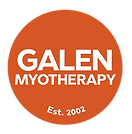Choice (noun) an act of choosing between two or more possibilities."The choice between good and evil".
- Galen Myotherapy

- May 15, 2025
- 4 min read
This is what comes up if you search for the definition of the word “choice”. Which is really interesting as the meaning of the word “choice” is portrayed as a two dimensional meaning, “good and bad”, “yes or no”.
We know that many of our decisions are much more complex than that and often include a number of different factors and elements which will affect the decision we ultimately make.

This complexity of choice is no different for dogs, and will vary from situation to situation. A dog's decision, to us, may be as simple as “yes”, I need to go outside for a toilet break, or “no” I don’t need to go outside.
But there could well be a conflict of emotions and considerations behind that apparently simple decision. The choice not to go outside may be due to pain or discomfort, not that they don’t need to go out. Perhaps the route to the outside space is across a slippery floor, and to walk across it will be painful, the dog knows their paws might slip and they remember that this may lead to discomfort, so ultimately they choose to delay the decision to go out, until later. Meaning that this particular choice has been defined by a variety of factors.
This complexity of choice is something that we need to be aware of in all aspects of our dogs lives. As Galen Myotherapists we understand that we will be treating areas of myofascial discomfort. We also need to consider whether a dog is happy to be touched, perhaps they may be wary of newcomers, could they have been affected by previous medical experiences? In order to counteract these concerns, we need to ensure that the dog has space to move away if they are feeling overwhelmed, physically and emotionally, and that they are given time to process the experience. This is the fundamentals of Galen Myotherapy’s Positive PACT and this is what sets us apart from many other similar physical therapies.

To put this into a human context, imagine going for a massage, whether it's sports, deep tissue or relaxing, and on arrival being told not to speak or move during the treatment. And to make it worse you are on a high table which you can’t even get off as it is too high to jump down without risking hurting yourself.
How would this make you feel? Scared, uncomfortable, would you turn around and leave? If you do stay for the massage, can you relax, knowing that you have no voice and cannot move away if you are in pain or discomfort? Imagine also the effect of this emotional and physical stress of this situation on your body as a whole, this would not be an experience you would be prepared to undergo again.
The Link Between Muscles, Fascia, and Emotions
Muscles and fascia are vital for movement, stability, and support. They are also closely connected to the nervous system, which regulates our emotions. When muscles and fascia become tense, they can interfere with the nervous system's function.
Common Areas of Tension and Their Emotional Impact
Shoulders and Neck: Tension here can cause headaches and general discomfort.
Chest and Abdomen: Tightness in these areas can contribute to feelings of anxiety and panic, as these muscles are involved in breathing and regulating the sympathetic nervous system.
Jaw: Many people clench their jaw or grind their teeth when stressed, leading to tightness, soreness, and pain.
Face: Holding tension in the face, particularly around the eyes, forehead, and mouth, is a common response to stress and anxiety, potentially causing headaches, eye strain, and wrinkles.
Abdomen and Solar Plexus: Stress and anxiety, both short-term and long-term, often cause tension in this area, resulting in stomach discomfort, indigestion, and chest tightness. The fascia here can become tight and rigid due to emotional stress.
Hands: Clenching fists or gripping objects tightly when feeling overwhelmed or anxious can lead to muscle tension and pain in the hands and wrists.

Muscle tension is a common physical reaction to stress, anxiety, physical strain, and poor posture, and it can be felt throughout the body. Addressing this tension is crucial not only for physical, but also emotional well-being.
Dogs can be affected by these same myofascial issues listed above. So it is important to understand that although a dog may be in myofascial discomfort and pain, this cannot and should not be divorced from emotion and emotional discomfort. This is why the only ethical approach to treating a dog with a manual therapy is from a 360 perspective, we need to be looking at all the physical and emotional elements, such as posture, demeanour, behaviour and medical history.
This is why Galen Myotherapists will only ever treat with “choice”, which involves closely watching a dog's body language and looking for any small nuances that may indicate that they are uncomfortable; allowing us to adjust the area we treat on their body, whilst also ensuring we deliver effective, targeted treatment. By allowing a dog the opportunity to move away from the treatment area, by treating at floor level and never using any form of restraint, allows dogs to gain confidence in their autonomy within this scenario and to always have their “voice”.
If you would like to read more about our scientifically cited Positive PACT paper click here.
REFERENCES
Bruno Bordoni, Fabiola Marelli; Emotions in Motion: Myofascial Interoception. Complement Med Res 28 April 2017; 24 (2): 110–113. https://doi.org/10.1159/000464149








Comments